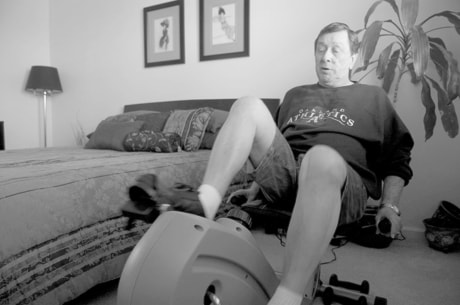In the end, he knew it was inevitable. The only question was, how many years would pass before Bill Moriarity got knee-replacement surgery?
How long before moving became unbearably painful and walking unencumbered nearly impossible? How long before the Sacramento, Calif., man’s rheumatologist, Dr. Kenneth Wiesner, would stop performing the “stopgap measures” — arthroscopic surgery, anti-inflammatory injections, pain medications — and send him in for new parts?
All along, the goal for Moriarity, who first started seeing Wiesner at age 45, was to reach age 60, au natural. He made it to 67, which both Moriarity and Wiesner consider a victory. Albeit a hollow one.
“Wiesner said to me later, ‘Frankly, I thought you had no chance in hell of making it,’” Moriarity recalls. “Your knees were like ground glass.”
Ultimately, experts say, replacement is the only known “cure” for osteoarthritis in the knee, arguably the body’s most used and abused joint. But most surgeons hesitate to operate on patients younger than 60 because, as Wiesner bluntly puts it, “the prosthesis won’t last as long as you do.”
The problem is, these days, people’s knees are wearing out at a much quicker rate. The aging baby-boomer population is staying much more active into middle age than the previous generation, necessitating earlier intervention.
Nearly 200,000 Americans ages 45 to 64 had knee replacements in 2006, accounting for 39 per cent of total replacement surgeries, according to the American Academy of Orthopaedic Surgeons. All told, more than 20 million people a year visit the doctor because of knee pain. Osteoarthritis occurs in six per cent of people 30 and older and jumps to 11 per cent by age 65, according to a separate organization, the Arthritis Foundation.
And the numbers are going to rise. It’s not just the prevalence of anterior-cruciate-ligament surgeries for athletes; garden-variety torn meniscus (cartilage) and worn-away cartilage also contribute to osteoarthritis.
Wiesner says it’s obvious why doctors are treating more osteoarthritis, also known as OA. We simply put too much strain on our knees for the following reasons:
1. Obesity: Because three times a person’s weight is transferred to the knees (and hips) during even the simplest weight-bearing activities such as standing or walking, extra weight adds significantly more stress. An extra 10 pounds on a person’s frame feels like 60 pounds to the knees.
One study found that people can decrease the risk of knee arthritis by losing as little as 10 to 15 pounds.
“We know that women who are overweight have a higher likelihood of developing OA, just based on weight alone,” Wiesner says. “For men, it’s not as big a factor, for some reason.”
2. Sports participation: Studies found that knee injuries, especially in middle age, hasten arthritis in the joint. But even without major trauma, repeated use of joints on the job (bending and lifting) or in sports such as running becomes high-risk.
“Who do I see in my office? People who played high-school football and soccer,” Wiesner says. “A 45-year-old goes to the orthopedist with pain, and he’s too young to replace a knee. What do they do? Live with it, which is terrible for a 45-year-old.”
3. Longevity and family history: Wiesner says that, with each generation living longer, osteoarthritis will become more prevalent. And he says those who have a genetic disposition for knee pain should take proactive measures such as exercising the muscles surrounding the knee, keeping weight down and choosing low-impact sports.
There are some medical advances, says Wiesner. One is injecting synthetic substances that augment the thinning synovial fluid (sort of a WD-40 for the knees) in the joint.
“But if you have no cartilage left in the knee, which often happens, that’s not going to work to lubricate the knee,” Wiesner says.
That eventually became Moriarity’s painful plight — bone-on-bone grinding. In his case, sports was the culprit. He played baseball and other sports (“full tilt”) from high school to age 45, when his knees swelled so badly he could barely move them.
Wiesner diagnosed osteoarthritis and performed arthroscopic surgery to, as Moriarity says, “clean out debris and trim cartilage.” Over the years, he had that procedure a few times, as well as rounds of injections and analgesic medications.
“It helped extend the life of the knee,” says Moriarity, a former English professor at California State University-Sacramento. “But finally, there was too much pain. I was dragging my left leg. Effectively, I was a cripple.”
As early as four days after surgery on both knees, Moriarity said, the pain had significantly lessened and the range of motion was returning.
He’s been vigilant about exercising to strengthen the muscles around the knees and is walking with no problem and taking stairs in his house with no creakiness.
He admits missing a more active life, though.
“I’ve got a brother-in-law who played pro ball (baseball) and he’s 71 now and still playing senior softball, traveling all over the country,” Moriarity says.
“It’s just the luck of the genetic draw, I guess.”
